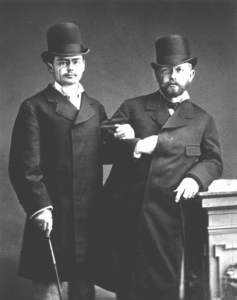On October 26, 27 and 28, acclaimed guest conductor Fabien Gabel leads Tchaikovsky’s Violin Concerto, featuring violinist Karen Gomyo. In this post, learn more about Tchaikovsky’s Romantic masterpiece and the surprising relationship that inspired it.
Tchaikovsky wrote his Violin Concerto in March 1878 while staying amid the breathtaking mountains of Clarens, Switzerland on Lake Geneva. The work was spurred by a visit from the violinist Iosif Kotek, who had been asking Tchaikovsky for a violin concerto for some time. After playing through Lalo’s Symphonie espagnole together, Tchaikovsky’s imagination was fired with ideas.
He Plays the Violin

Kotek had been one of Tchaikovsky’s admiring students at the Moscow Conservatory, but the two only became close after Kotek’s graduation in 1876. In January 1877, Tchaikovsky confessed his feelings for the violinist in a letter to his brother Modest: “I am in love, as I haven’t been in love for a long time.” Though Kotek was primarily heterosexual, he seems to have returned Tchaikovsky’s feelings.
The intensity of their infatuation soon cooled (no doubt in part due to Kotek’s rather active heterosexual pursuits), but Kotek would nevertheless continue to be one of Tchaikovsky’s closest friends. Kotek provided Tchaikovsky with critical emotional support during and after the composer’s disastrous marriage that summer. After only a few unhappy months with his wife, Tchaikovsky realized he would never be able to lead a conventional family life and escaped abroad, hoping to avoid scandal and recover from the psychologically devastating episode (see also Tchaikovsky’s Fourth Symphony). With a generous allowance from his new patroness Nadezhda von Meck (a relationship Kotek had helped foster), Tchaikovsky visited Austria, Italy and Switzerland, where Kotek rejoined him.
Work on the concerto progressed quickly; Tchaikovsky would write a passage and Kotek would try it out, giving Tchaikovsky valuable feedback regarding violin technique. The masterpiece that emerged would become one of the most beloved violin concertos in history.
The Music
The piece opens with an introduction for the orchestra that begins calmly, but soon becomes passionate:
This gives way to the entrance of the soloist, who introduces the first movement’s main melody, one of Tchaikovsky’s most beautiful themes. The soloist’s music becomes faster and more virtuoso as it unfolds, until we reach a new theme marked “con molto espressione” (with great expression). Though related to the main melody, this theme is warmer, with a faster harmonic rhythm. As it unfolds and develops, the soloist’s music once again becomes increasingly virtuoso, but now with added emotional intensity. The soloist’s runs build to a grand orchestral statement in which the main theme returns in a powerful, heroic guise.
This soon disintegrates into fragmentary, unstable music, until the soloist reenters with a delicate variation on the main theme. This builds once again to a heroic, orchestral version of the theme. The music becomes more intense, until it breaks off, leaving the soloist alone. The soloist then plays a cadenza, an extended unaccompanied solo of great difficulty that features some of the violin’s highest notes.
After revisiting the main theme and the second theme, the cadenza ends with a trill, the traditional signal for the orchestra to reenter, and the flute begins to play a reprise of the main theme. After a reprise of the second theme, the orchestra and soloist race to the end of the movement in a thrilling coda.

The slow movement that appears in the concerto today was not the one Tchaikovsky originally wrote; Kotek thought the original version was nice enough, but believed Tchaikovsky could do better. Tchaikovsky obliged, and wrote the unforgettable Canzonetta as a replacement (the original movement later became the Meditation from Souvenir d’un lieu cher—“Memory of a dear place”). “Canzonetta” is Italian for “little song,” and indicates a simple, vocal style of music. After a chorale-like introduction from the woodwinds, the soloist indeed plays a simple, song-like melody that is sweet yet melancholy. A brief orchestral interlude leads to a warmer, more tender middle section. After a reprise of the main theme and the introductory chorale, the movement fades away.
Just as the second movement is about to end, the finale begins with a bang. Parallel to the first movement, an animated orchestral introduction leads to the entrance of the soloist, who then introduces the dancing main theme of the movement. In place of the noble melodies of the previous movements, Tchaikovsky turns now to the earthy sounds of Russian folk music, casting the soloist as a virtuoso Russian fiddler. Impressive passages for the soloist lead to a new theme that appears above a rustic drone bass. Languorous at first, the tune takes on a variety of moods in a series of variations, from fast and brilliant to slow and dreamy. The soloist then accelerates to a reprise of the main theme. After a reprise of the second theme, the main theme then reappears once more, leading to an exhilarating coda.
Everybody’s A Critic
Tchaikovsky wanted to dedicate his new concerto to Kotek, but worried that such a dedication might invite malicious gossip. Instead, he dedicated it to the famous Hungarian violinist Leopold Auer, for whom he had already written his Sérénade mélancolique. Unfortunately, Auer rejected the piece as unplayable. Possibly wounded by Tchaikovsky’s decision to dedicate the work to another, Kotek, too, refused to perform the work, and their friendship never recovered.

The premiere would not take place until 1881, when the violinist Adolph Brodsky decided that the unplayable concerto was playable after all. The premiere took place in Vienna and the work received enthusiastic applause; the critics, however, were harsh. Eduard Hanslick, an influential champion of Brahms and Dvořák, particularly criticized the Russian earthiness of the finale in his infamous review:
“The Russian composer Tchaikovsky is surely not an ordinary talent, but rather an inflated one, with a genius-obsession without discrimination or taste. Such is also his latest, long and pretentious Violin Concerto. For a while it moves soberly, musically, and not without spirit. But soon vulgarity gains the upper hand, and asserts itself to the end of the first movement. The violin is no longer played; it is pulled, torn, drubbed. The Adagio is again on its best behavior, to pacify and to win us. But it soon breaks off to make way for a finale that transfers us to a brutal and wretched jollity of a Russian holiday. We see plainly the savage vulgar faces, we hear curses, we smell vodka. Friedrich Vischer once observed, speaking of obscene pictures, that they stink to the eye. Tchaikovsky’s Violin Concerto gives us for the first time the hideous notion that there can be music that stinks to the ear.”
Tchaikovsky memorized Hanslick’s review and could quote it word for word for the rest of his life. Fortunately, Hanslick’s opinion didn’t seem to matter much on this occasion, as Brodsky soon had many more engagements to perform the concerto in other cities.
Tchaikovsky would not see Kotek again until 1884, when the violinist was dying of tuberculosis in a sanatorium in Davos, Switzerland. Putting aside past differences, Tchaikovsky went to say farewell to his friend, offering him what comfort he could. Kotek died at the beginning of the new year, aged only 29 years old. Tchaikovsky was deeply grieved, as evidenced by his brief diary entry a year and a half later: “Kotek’s letters. Tears.” —Calvin Dotsey
Don’t miss Tchaikovsky’s Violin Concerto on October 26, 27 & 28, 2018! Get tickets and more information at houstonsymphony.org.



